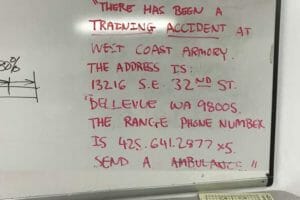
Pedestrian versus Autos – expanding our thinking on injuries caused by terrorist attacks
- Posted by Mike Shertz MD/18D
- Categories (S) Security & Awareness
🕖 Reading Time, 8 minutes. (UPDATED 31 March 2024)
There is little existing medical literature on casualties intentionally run over by vehicles, but several patterns become apparent.
On 19 December, 2016 a truck was intentionally driven into a Christmas market in Berlin leaving 13 dead and another 56 inured. The Islamic State claimed responsibility for the attack. Although intentional terrorist vehicle ramming attacks seem to have decreased in the last few years, they remain a continued high lethality, but low complexity means of attack. Note the installed anti-vehicle barricades that have been placed since.


ISIS previously encouraged its followers to rent SUVs and trucks for the purpose of wounding and killing civilian populations and intentional vehicle ramming continues to be used as a global weapon. Others have found themselves at events in the US where lone drivers have plowed through crowds.
- In December 2015, a car intentional plowed through a crowd on a sidewalk near the Paris Las Vegas and Planet Hollywood resorts in Las Vegas. One tourist was killed and another 35 wounded. Since then picket-like vehicle barriers called bollards now line Las Vegas Boulevard to protect pedestrians.
- In November 2021, a sport utility vehicle was intentionally driven through an annual Christmas parade in Waukesha, Wisconsin killing 6 people and injuring 62 others.
- In May 2023, a driver who crashed into a bus stop outside a Brownsville migrant center killed eight people and injured 10 more, was charged with manslaughter, though police are still investigating whether he intentionally drove into the crowd.
- In October 2023, a Los Angeles man was arrested on suspicion of murder after authorities accused him of intentionally driving his vehicle into a group of pedestrians in a Long Beach crosswalk.
Therefore, it is worth reviewing the trauma literature of pedestrians injured by automobiles.
Medical Literature
There is little medical literature on casualties intentionally run over by vehicles. One study looked at the Israeli experience, as this method of attack first occurred there in 1987. One major difference between accidental auto versus pedestrian collisions and intentional attacks is the vehicle speed. In general, unintentional collisions involve the vehicle trying to decelerate rather than a deliberate acceleration in vehicle-ramming attacks.1
Several patterns are clear from the existing literature on pedestrians injured by automobiles:
- A German2 study of cars hitting pedestrians at speeds over 13 mph found the fatality rate was about 24%, with approximately 8% dead on the scene. Fatality rates significantly increase if the casualty was hit at speeds over 30 mph.
- The driver of the car used during the Westminster Bridge attack was traveling at 76 mph by the time he reached the end of the bridge. Five died (not including the attacker), and 49 were injured (9% killed).
- The truck attack in Nice in 2016 killed 85 and wounded another 434 (16% killed).
- In the 2016 Christmas-time Berlin attack, the driver killed 13 (including the registered driver of the truck who was kidnapped and killed as he tried to avert the attack) and left 56 wounded (17% killed). Witnesses estimated the truck was traveling 40 mph.
- August, 2017 attack in Barcelona killed 13 and injured 131 (10% killed). Witnesses described the vehicle as driving at “high speeds.”
Injury Patterns in pedestrian vs. automobiles
Essentially, pedestrians who ultimately die from vehicle crashes have head injuries, largely subarachnoid bleeding, and brain contusions. This may be more likely in intentional ramming as the victim is hurled toward/into the vehicle by acceleration rather than pushed away by deceleration of the accidental, surprised driver.1
Blunt chest and abdominal injuries were the next most frequent life-threatening conditions after a high-energy impact. Injuries to the chest, spine, and pelvis occurred in decreasing order of frequency.
- Most chest injuries included multiple rib fractures and lung contusions.
- Spleen and liver rupture were the most common abdominal injuries.
- Unstable thoracic and cervical spine fractures were the leading cause of spine injuries.
- Anterior pelvic ring fractures were the most common injury to the pelvis.
Head Injuries

The Israeli study showed a much higher rate of severe head injuries and a fourfold increase in prehospital intubation rates compared to accidental auto vs. peds (27% vs. 7%).
Prehospital management of head injuries largely is supportive and tries to avoid the “second injury” of hypoxia or hypotension (low oxygen levels and abnormally low blood pressure, respectively), both of which markedly increase the likelihood of death from an already injured brain. A single episode of hypotension in the head-injured increases their mortality by 2.5 times. A single recorded hypoxic oxygen saturation increases their death rate three times. If they have both hypotension and hypoxia, their mortality increases by six-fold.3
Torso Injuries
Multiple rib fractures can cause death by compromising the casualty’s respiratory function both mechanically (think flail chest) and through underlying hemo / pneumothorax, tension pneumothorax, and lung contusion. Imagine breathing through a wet sponge: Oxygen transport through blood-soaked bruised lungs is poor.
Liver and spleen rupture can cause substantial intra-abdominal bleeding with hypotension (making the associated head injury worse). Blood transfusions are often required, and surgery may be necessary to control the bleeding.
Pelvic fractures can be life-threatening because of the major vasculature that is often torn with a significant bony break and the large volume of the pelvis, allowing significant internal bleeding into what is essentially a large bowl.
Spinal Fractures

While unstable spinal fractures are rare in penetrating trauma, the bullet or fragment either touched your spine, or it didn’t,4 they are very common in pedestrians injured by automobiles. In the German study, unstable spinal fractures were the majority occurring in 9 of 11 spine fractures. What you need to know: All of this complicates casualty movement. With stable spinal fractures from penetrating trauma, moving a casualty without regard to spinal precautions rarely worsens their injuries. With unstable fractures from a vehicular crash, they are by definition fragile, and any extra spinal motion increases the possibility of spinal cord injury.
Summing all this up
The majority of life-threatening injuries occurring in pedestrians hit by motor vehicles are blunt trauma injuries. Fortunately, civilian prehospital providers have extensive experience dealing with blunt trauma, as it is the majority cause of trauma in developed nations.
TCCC and TECC guidelines are optimized largely for casualties of penetrating trauma. Thirty six vehicle ramming attacks in Israel between 2015 and 2019 generated 133 casualties, 89 (79%) of which were IDF soldiers. Tourniquets were placed on 4 casualties (3.5%), hemostatic gauze packing in 3 (2.7%), endotracheal intubation in 4 (3.5%), and needle decompression on 2 (1.8%). Though 75% of the casualties had injured extremities, it is rarely a life-threatening injury in these types of attacks. The most common fatal injury in these kinds of attacks is blunt head trauma.5
As a bystander, you must consider your safety first. Running to aid the injured in a vehicle ramming attack may put you in the path of an oncoming attacker, as these attackers often exit their vehicles once they have crashed and begin stabbing people. If it is safe to help, your first priority is to ensure the EMS system has been activated: Call 911. Most of these injuries will require paramedic-level training and an ambulance of supplies to manage. Avoid moving casualties unless to prevent greater harm, such as from an encroaching fire or other vehicles. Then, work the MARCH pneumonic as best as you can: prioritize external bleeding control, maintain an open airway, and prevent hypothermia.
Interested to learn more? Try our online courses, or get started with a sample of the material in the preview course.
References
1Almogy, G., Kedar, A. & Bala, M. When a vehicle becomes a weapon: intentional vehicular assaults in Israel. Scand J Trauma Resusc Emerg Med 24, 149 (2016). https://doi.org/10.1186/s13049-016-0338-9
2 Schmucker U, Beirau M, Frank M, Stengel D, Matthes G, Ekkernkamp A, Seifert J. Real-world car-to-pedestrian-crash data from an urban centre. J Trauma Manag Outcomes. 2010;4(1):2.[PMC free article] [PubMed]
3Spaite DW, Hu C, Bobrow BJ, Chikani V, Barnhart B, Gaither JB, Denninghoff KR, Adelson PD, Keim SM, Viscusi C, Mullins T, Rice AD, Sherrill D. Association of Out-of-Hospital Hypotension Depth and Duration With Traumatic Brain Injury Mortality. Ann Emerg Med. 2017 Oct;70(4):522-530
4Haut ER, Kalish BT, Efron DT, Haider AH, Stevens KA, Kieninger AN, Cornwell EE 3rd, Chang DC. Spine immobilization in penetrating trauma: more harm than good? J Trauma. 2010 Jan;68(1):115-20
5Tsur AM, Nadler R, Sorkin A, Lipkin I, Gelikas S, Chen J, Benov A. Patterns in vehicle-ramming attacks. Isr Med Assoc J. 2022 Sep;24(9):579-583.
US DHS has an overview of the topic in their Vehicle Ramming: security awareness for soft targets & crowded places
Dr. Mike Shertz is the Owner and Lead Instructor at Crisis Medicine. Dr. Shertz is a dual-boarded Emergency Medicine and EMS physician, having spent over 30 years gaining the experience and insight to create and provide his comprehensive, science-informed, training to better prepare everyday citizens, law enforcement, EMS, and the military to manage casualties and wounded in high-risk environments. Drawing on his prior experience as an Army Special Forces medic (18D), two decades as an armed, embedded tactical medic on a regional SWAT team, and as a Fire Service and EMS medical director.
Using a combination of current and historical events, Dr. Shertz’s lectures include relevant, illustrative photos, as well as hands-on demonstrations to demystify the how, why, when to use each emergency medical procedure you need to become a Force Multiplier for Good.



